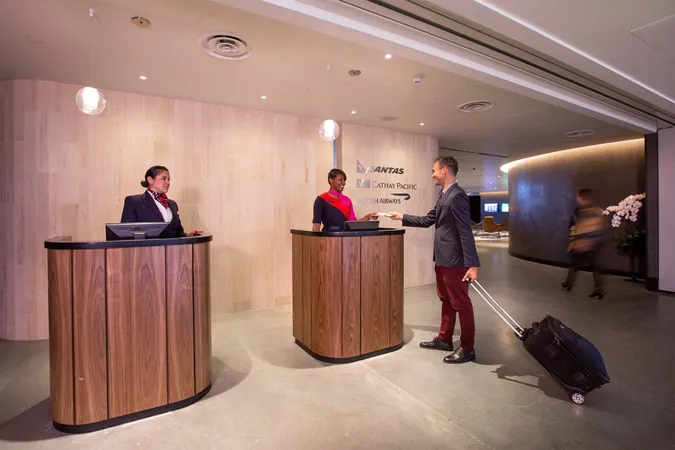
Who's Really Footing the Bill for Your Airport Lounge Access?
2025-01-13
Author: Sarah
As the world reopens post-pandemic, international travel is booming, and airport lounges are once again becoming an essential part of the overall travel experience. The Asia-Pacific region, once slow to emerge from restrictions, has seen a remarkable revival in lounge access due to heightened travel demand, leading to increased competition among airlines.
For many travelers—be it the frequent flyer seeking respite from chaotic terminals, a business traveler enjoying a quick shower and reliable Wi-Fi, or a First Class passenger pampering themselves with a drink before their flight—lounge access has grown in importance over the years. No longer just a nice-to-have, airport lounges now rival in-flight offerings in terms of premium experience.
Airlines have recognized this shift, pouring significant investment into their lounges, particularly carriers like Cathay Pacific, Singapore Airlines, United Airlines, and Qantas. In Singapore, we’ve recently witnessed a surge in lounge openings, including the flagship Singapore Airlines lounges at Changi Airport's Terminal 3, which opened in 2022. Even pre-pandemic, top-notch facilities from airlines like Qantas, Cathay Pacific, and Qatar Airways enhanced the lounge landscape at Changi, creating a plethora of fantastic options for travelers flying with premium airlines.
But as lounge access becomes more popular, a common question arises: who pays for it?
Lounge Access Schemes
If you're using a lounge access program like Priority Pass, you're tapping into a vast network of lounges across the globe. The way these schemes work is simple: the access provider pays a fee to lounge operators every time a member visits. For instance, if you pay $329 for an annual Priority Pass that includes ten visits, the provider essentially pays around $32.90 for each visit to the lounge operator, retaining the remainder as their margin. If you have an unlimited access membership through a premium credit card, the access provider benefits from collecting a fixed fee, banking on the average number of uses per member to manage operational costs.
Access by Travel Class
In many cases, if your ticket allows lounge access based on your travel class, the airline you are flying with usually covers the bill. For example, a Business Class passenger on Malaysia Airlines might choose to relax in the Oneworld lounges at Changi Airport; here, Malaysia Airlines will cover the lounge fees charged by Qantas and British Airways for those visits.
Most airlines establish their own lounges in key locations to eliminate the need to pay rivals or third-party providers for lounge usage. By managing their own facilities, airlines maintain better control over customer experience and brand consistency. Operating lounges is expensive, but the benefits often outweigh the costs, especially on essential business routes.
The Codeshare Conundrum
Things get a bit trickier with codeshare flights. If you're traveling on a codeshare, your lounge access may be covered by a different airline than the one you're flying. For example, say you're traveling in Business Class on Malaysia Airlines but booked under a Singapore Airlines code; Singapore Airlines would pay for your lounge access in this scenario.
Frequent Flyer Status
Access through elite status with a frequent flyer program also has its nuances. If you have elite status but are flying a basic Economy fare on an alliance airline, the lounge access is generally covered by your frequent flyer program. For example, if a Singapore Airlines KrisFlyer Elite Gold member is flying Economy on Air Canada and opts for the United Club lounge, Singapore Airlines will handle the payment.
Who Pays How Much?
While specific rates are often shrouded in secrecy, industry insiders suggest that airlines typically pay anywhere from $40 to $60 for lounge access in such scenarios. Pre-pandemic figures indicated United Airlines paying Singapore Airlines around $60 for each eligible Business Class passenger entering the SilverKris lounge, and vice versa. Such costs highlight the value of lounge access, showcasing the competitive landscape among airlines and their commitment to maintaining premium customer care.
Summary
Ultimately, understanding who pays for your lounge access can transform your travel experience. If your travel class qualifies for lounge access, the airline typically covers the costs. If it's your frequent flyer status that grants access, then the associated airline takes care of the payment.
In an age where travel experience is paramount, and lounge amenities are vying for the limelight, being informed can give you an edge—ensuring you make the most of your airport time. So next time you kick back in a luxurious lounge, you might just appreciate the intricate web of agreements that made that moment possible!



 Brasil (PT)
Brasil (PT)
 Canada (EN)
Canada (EN)
 Chile (ES)
Chile (ES)
 Česko (CS)
Česko (CS)
 대한민국 (KO)
대한민국 (KO)
 España (ES)
España (ES)
 France (FR)
France (FR)
 Hong Kong (EN)
Hong Kong (EN)
 Italia (IT)
Italia (IT)
 日本 (JA)
日本 (JA)
 Magyarország (HU)
Magyarország (HU)
 Norge (NO)
Norge (NO)
 Polska (PL)
Polska (PL)
 Schweiz (DE)
Schweiz (DE)
 Singapore (EN)
Singapore (EN)
 Sverige (SV)
Sverige (SV)
 Suomi (FI)
Suomi (FI)
 Türkiye (TR)
Türkiye (TR)
 الإمارات العربية المتحدة (AR)
الإمارات العربية المتحدة (AR)